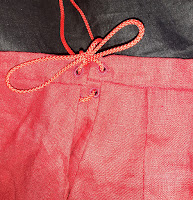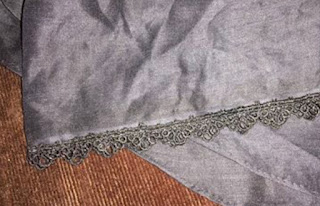Category: With silken coats, and caps, and golden rings, with ruffs, and cuffs, and farthingales, and things. A garment your persona may have worn.
Purpose:
I bought some beautiful red silk/wool blend and, as there are many red Portuguese dresses in the pictures of the 1520s, I thought that this was a good plan to keep up with the fashions! I also wanted to try something in keeping with the St Auta altarpiece dresses. I did not want to make one specific dress but incorporate a number of the features seen in this painting.
 |
Martyrdom of St Ursula and the 11,000 Virgins, Master of St Auta
|
Materials used:- 7m silk/wool blend
- Under 1m of cotton/linen canvas and white cotton
- Shot green/grey/gold silk
- Lots of gold and wine coloured trim
- 2 rolls of gold embroidered trim
- Metal eyelets
- Cotton tape for hemming
- Red cord for lacing
Method:
While my other Portuguese dress has a kirtle underneath I wanted this dress to be worn alone for my personal comfort. While many of the St Auta dresses appeared to open at the front, for aesthetic reasons I preferred to have the openings at the side back which can be seen in extant Italian gowns, especially Eleanor of Toledo’s. The Portuguese portrait of Queen Catherine as St Catherine is also clearly laced at the back and this dates from the late 1520s/early 1530s.
I used the pattern for my previous dress and cut out two front and back bodice pieces out of the cotton canvas as interlining. I then cut out the bodice in a piece of thin cotton batting. I zigzaged these three pieces together to make an inner support layer.
I cut out a bodice with seam allowance from the red silk and whip stitched this by hand over the canvas layer. I then whip stitched the cotton lining in place.
Angus put the eyelets in for me but I then couched over them by hand so they blended into the silk and for extra reinforcement.
I sewed the trim around the neckline. This trim placement can clearly be seen on the back of the beheaded lady in the red dress at the bottom of the St Auta altarpiece and on Queen Catherine’s dress. The trim matched the colour of the silk perfectly and while I can’t say it is specifically Portuguese it looks fabulous.
The skirt is four gored panels which are machine sewed together. This is then box pleated (by hand) to the bodice which is consistent with the Queen Catherine dress. I hemmed the skirt by machining wide cotton bias tape to the bottom. I then folded this inside the skirt and machined in place. I machined the trim on top of this on the outside of the skirt. This was because I was running short on time and even as I write this I have had to check multiple times how it was put together so it is not obvious.
I wanted to do sleeves like those on one of the St Auta side panels
These are fairly full with the opening down the back of the arm secured with ties. It is then tied
on to the bodice. I was fascinated that these sleeves and one in the centre of the 11000 Virgins painting appear to have a turned back cuff that has a wide fancy trim on it. The sleeves also appear to be lined in a different colour to the rest of the dress.
I found a beautiful gold/grey/green silk in my stash which worked beautifully with the silk and trim so I lined the sleeves in that.
On the turned back cuff I attached some wide gold-work style trim I found at Spotlight and attached the red/gold trim down the opening of the sleeves and used it on the bodice as loops to tie the sleeves to.
I cut a two inch strip out of the sleeve lining silk and then, by hand, whip stitched it closed. I cut this into lengths and attached an aglet to each end of these lengths to make ties. These I attached down the length of the sleeve opening when I attached the lining. I tied them together to make the sleeves. I made some others as ties at the top of the sleeve so it could be attached to the bodice.
I made a sash out of the same shot silk and put some of the wide trim (from the sleeve cuff) on the ends of it and added gold fringing.
Verdict:
I love this dress and enjoyed wearing it to the Spring Feast at Gildenwick. I think in the next version I will alter the cut of the sleeves slightly so the opening is more visible at the back of my arm and the cuff is more parallel to my wrist. I am enjoying my forays into Portuguese clothing as it is pretty and comfy! It worked well with my new Portuguese hat too!
Useful links:






















